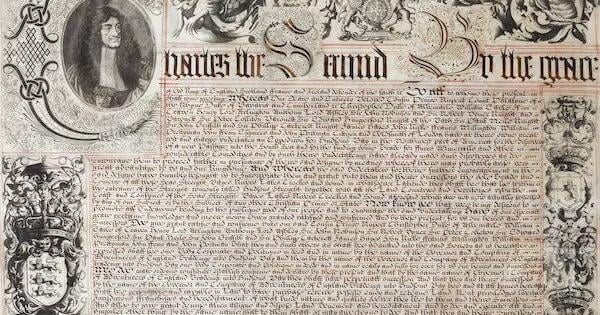TORONTO – Two of Canada’s wealthiest families want to team up to make an $18 million bid for the royal charter that formed Hudson’s Bay Company and donate it to a group of museums to ensure the historic document’s preservation.
Court documents filed late Friday say holding companies belonging to the Thomson and Weston families have joined forces to put an even higher price tag on the 1670 document that created the fur-trading business-turned department store.
Media baron David Thomson and his firm, DKRT Family Corp., previously offered $15 million for the charter, after the Westons, of Loblaw Cos. Ltd. fame, offered $12.5 million through their company, Wittington Investments Limited.
The joint offer is aimed at buying the document so it can be shared among the Archives of Manitoba, the Manitoba Museum, the Canadian Museum of History, and the Royal Ontario Museum.
The proposed bid puts to rest speculation about who was behind a mystery offer received by HBC in late September, when it was due to seek court approval for its plan to auction off the document.
HBC never said who made the bid, but court documents reveal the joint offer sat at $16 million at that point. The offer caused the company to put off asking the court’s permission for the sale and begin discussions with the families, who eventually increased the offer.
The documents filed Friday say HBC will ask again for the auction Nov. 21.
If the company gets the go-ahead, bidders must signal their interest by Nov. 28, and an auction will be held Dec. 3.
If the Weston and Thomson families win the sale, they will immediately donate the document to the consortium of four public institutions.
Two of the organizations — the Archives of Manitoba and the Manitoba Museum — already house many of HBC’s artifacts.
In 1994, the retailer gave the Archives of Manitoba maps dating back to 1709, as well as videos and audio recordings. There were also so many diaries, letters and research notes that textual records alone take up more than 1,500 linear metres of shelf space.
Meanwhile, the Manitoba Museum has 27,000 items, including furnishings from the company’s former head office in London, England and a birchbark canoe from the early 20th century.
The Thomsons’ and Westons’ new offer melds together several parts of their previous individual bids and offers $5 million to fund the conservation, education and tours for the charter.
Court filings say the Desmarais Family and Power Corp. of Canada, along with The Hennick Family Foundation, have also committed additional support.
The Westons’ original plan was to donate the charter to the Canadian Museum of History, a Crown corporation in Gatineau, Que., that traces Canada’s history from the dawn of human habitation to the present. It offered $1 million to preserve and share the charter.
The bid received in July was the first HBC received. It was so satisfied with the unsolicited overture that it started preparing to scrap plans for an auction and accept the Weston offer.
Then, the Thomsons swooped in and said they wanted to buy the document in an auction and give it to the Archives of Manitoba. The family was prepared to pony up $2 million.
The development pushed HBC to return to its original auction plan, which was put on pause once again when the joint bid came in.
In a statement, Galen Weston said his goal always has been to ensure the artifact is “preserved with care, shared with integrity and made accessible to all Canadians.”
David Thomson added he’s “proud to witness a group of private and public entities collaborate to support the preservation of the charter on behalf of all Canadians.”
If the joint offer is successful, the families say they want the four organizations receiving the charter to start a consultation process with Indigenous groups, museums, universities, archives, subject matter experts, and members of the general public to develop a sharing framework.
While the charter will be donated equally to the four public custodians, Manitoba will be designated its home and selected as the site for its first public exhibition after donation.
The Westons and Thomsons have given the province priority treatment because HBC was headquartered there after it moved its base from England to Canada. In more recent years, Toronto was its home.
Their plans have the support of all the organizations that would share the document, as well as the National Centre for Truth and Reconciliation.
The centre, in a letter filed with the court, said it is pleased with the families’ plan, as it “offers an opportunity to move beyond historical exclusion and towards a future rooted in partnership.”
Back when HBC was a goliath in the fur trade era and an extension of Britain’s colonial power, the charter gave it immense control over Indigenous land and its relationship with Indigenous peoples.
More recently, HBC has been trying to atone for its painful past.
“Placing the HBC charter in the hands of Canadians would mark a monumental step toward truth and reconciliation,” said Dorota Blumczynska, CEO of the Manitoba Museum, in a statement.
This report by The Canadian Press was first published Nov. 14, 2025.



